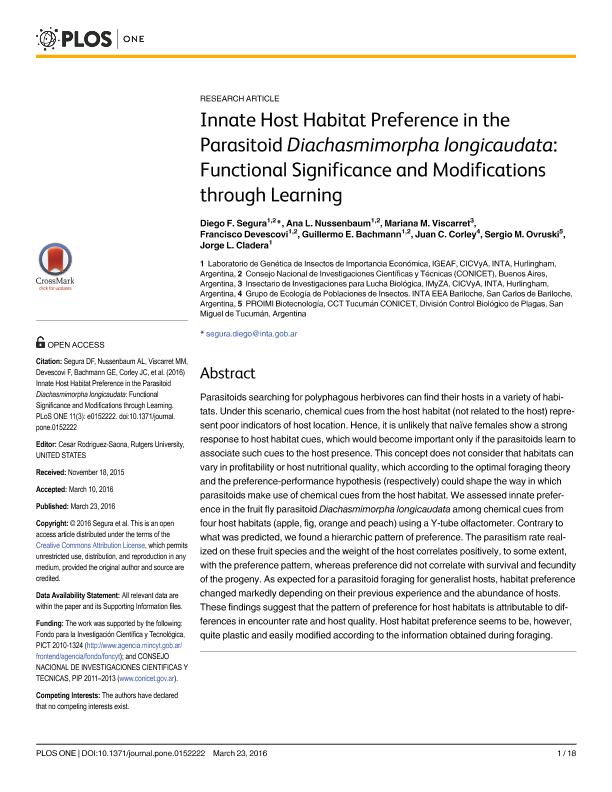Mostrar el registro sencillo del ítem
dc.contributor.author
Segura, Diego Fernando

dc.contributor.author
Nussenbaum, Ana Laura

dc.contributor.author
Viscarret, MM
dc.contributor.author
Devescovi, Francisco

dc.contributor.author
Bachmann, Guillermo Enrique

dc.contributor.author
Corley, Juan Carlos

dc.contributor.author
Ovruski, Sergio M.
dc.contributor.author
Cladera, Jorge Luis

dc.date.available
2018-02-27T21:31:02Z
dc.date.issued
2016-03
dc.identifier.citation
Segura, Diego Fernando; Nussenbaum, Ana Laura; Viscarret, MM; Devescovi, Francisco; Bachmann, Guillermo Enrique; et al.; Innate host habitat preference in the parasitoid Diachasmimorpha longicaudata: Functional significance and modifications through learning; Public Library of Science; Plos One; 11; 3; 3-2016; 1-18
dc.identifier.issn
1932-6203
dc.identifier.uri
http://hdl.handle.net/11336/37363
dc.description.abstract
Parasitoids searching for polyphagous herbivores can find their hosts in a variety of habitats. Under this scenario, chemical cues from the host habitat (not related to the host) represent poor indicators of host location. Hence, it is unlikely that naïve females show a strong response to host habitat cues, which would become important only if the parasitoids learn to associate such cues to the host presence. This concept does not consider that habitats can vary in profitability or host nutritional quality, which according to the optimal foraging theory and the preference-performance hypothesis (respectively) could shape the way in which parasitoids make use of chemical cues from the host habitat. We assessed innate preference in the fruit fly parasitoid Diachasmimorpha longicaudata among chemical cues from four host habitats (apple, fig, orange and peach) using a Y-tube olfactometer. Contrary to what was predicted, we found a hierarchic pattern of preference. The parasitism rate realized on these fruit species and the weight of the host correlates positively, to some extent, with the preference pattern, whereas preference did not correlate with survival and fecundity of the progeny. As expected for a parasitoid foraging for generalist hosts, habitat preference changed markedly depending on their previous experience and the abundance of hosts. These findings suggest that the pattern of preference for host habitats is attributable to differences in encounter rate and host quality. Host habitat preference seems to be, however, quite plastic and easily modified according to the information obtained during foraging.
dc.format
application/pdf
dc.language.iso
eng
dc.publisher
Public Library of Science

dc.rights
info:eu-repo/semantics/openAccess
dc.rights.uri
https://creativecommons.org/licenses/by-nc-sa/2.5/ar/
dc.subject
A
dc.subject.classification
Otras Ciencias Biológicas

dc.subject.classification
Ciencias Biológicas

dc.subject.classification
CIENCIAS NATURALES Y EXACTAS

dc.title
Innate host habitat preference in the parasitoid Diachasmimorpha longicaudata: Functional significance and modifications through learning
dc.type
info:eu-repo/semantics/article
dc.type
info:ar-repo/semantics/artículo
dc.type
info:eu-repo/semantics/publishedVersion
dc.date.updated
2017-12-04T18:01:09Z
dc.journal.volume
11
dc.journal.number
3
dc.journal.pagination
1-18
dc.journal.pais
Estados Unidos

dc.journal.ciudad
San Francisco
dc.description.fil
Fil: Segura, Diego Fernando. Instituto Nacional de Tecnología Agropecuaria. Centro de Investigación en Ciencias Veterinarias y Agronómicas. Instituto de Genética; Argentina. Consejo Nacional de Investigaciones Científicas y Técnicas; Argentina
dc.description.fil
Fil: Nussenbaum, Ana Laura. Consejo Nacional de Investigaciones Científicas y Técnicas; Argentina. Instituto Nacional de Tecnología Agropecuaria. Centro de Investigación en Ciencias Veterinarias y Agronómicas. Instituto de Genética; Argentina
dc.description.fil
Fil: Viscarret, MM. Instituto Nacional de Tecnología Agropecuaria. Centro de Investigación en Ciencias Veterinarias y Agronomicas. Instituto de Microbiología y Zoología Agrícola; Argentina
dc.description.fil
Fil: Devescovi, Francisco. Consejo Nacional de Investigaciones Científicas y Técnicas; Argentina. Instituto Nacional de Tecnología Agropecuaria. Centro de Investigación en Ciencias Veterinarias y Agronómicas. Instituto de Genética; Argentina
dc.description.fil
Fil: Bachmann, Guillermo Enrique. Consejo Nacional de Investigaciones Científicas y Técnicas; Argentina. Instituto Nacional de Tecnología Agropecuaria. Centro de Investigación en Ciencias Veterinarias y Agronómicas. Instituto de Genética; Argentina
dc.description.fil
Fil: Corley, Juan Carlos. Instituto Nacional de Tecnología Agropecuaria. Centro Regional Patagonia Norte. Estación Experimental Agropecuaria San Carlos de Bariloche; Argentina
dc.description.fil
Fil: Ovruski, Sergio M.. Consejo Nacional de Investigaciones Científicas y Técnicas. Centro Científico Tecnológico Conicet - Tucuman. Planta Piloto de Procesos Industriales Microbiologicos; Argentina
dc.description.fil
Fil: Cladera, Jorge Luis. Instituto Nacional de Tecnología Agropecuaria. Centro de Investigación en Ciencias Veterinarias y Agronómicas. Instituto de Genética; Argentina
dc.journal.title
Plos One

dc.relation.alternativeid
info:eu-repo/semantics/altIdentifier/url/http://journals.plos.org/plosone/article?id=10.1371/journal.pone.0152222
dc.relation.alternativeid
info:eu-repo/semantics/altIdentifier/doi/https://doi.org/10.1371/journal.pone.0152222
Archivos asociados
